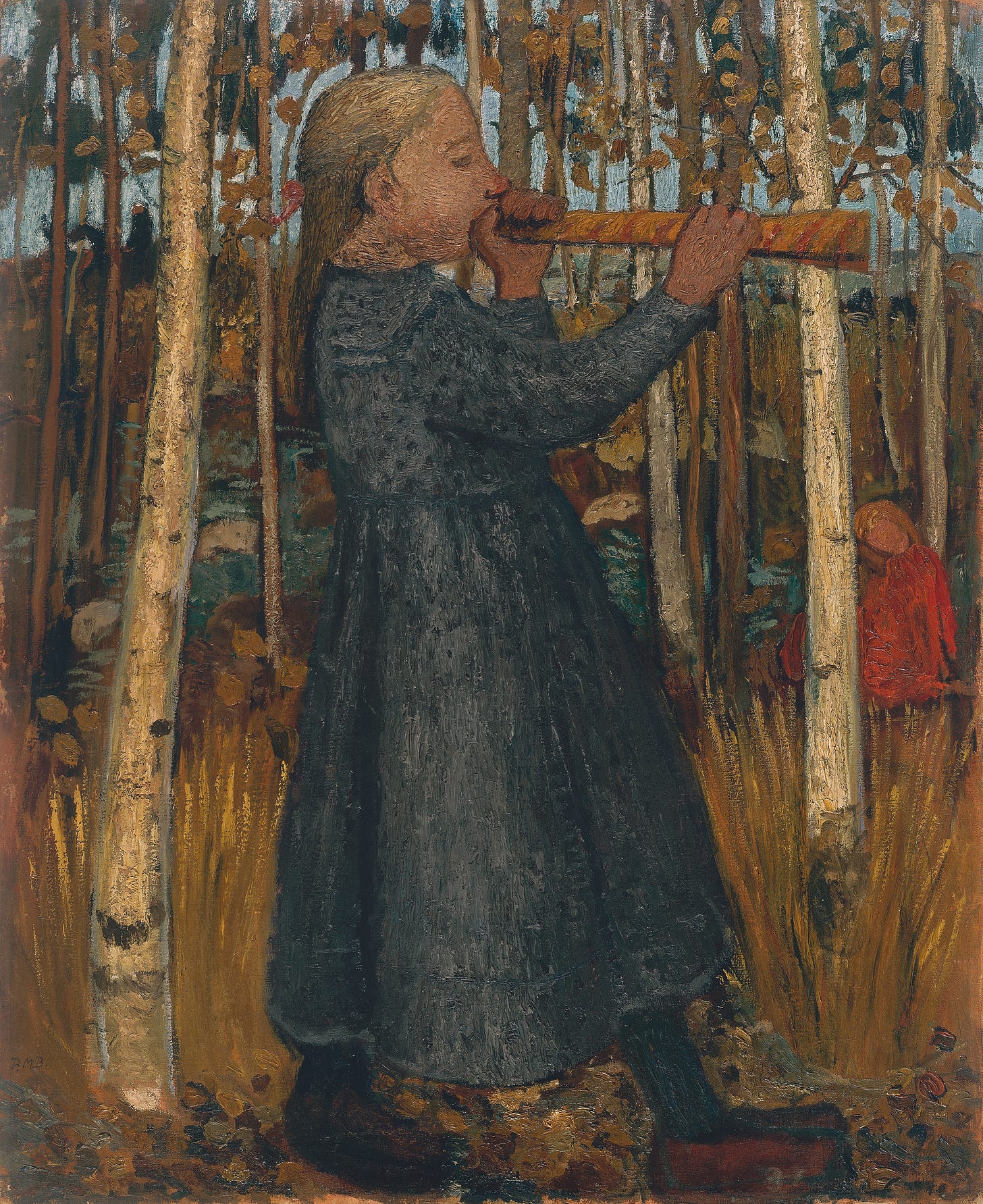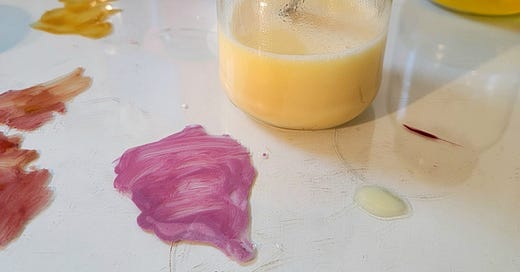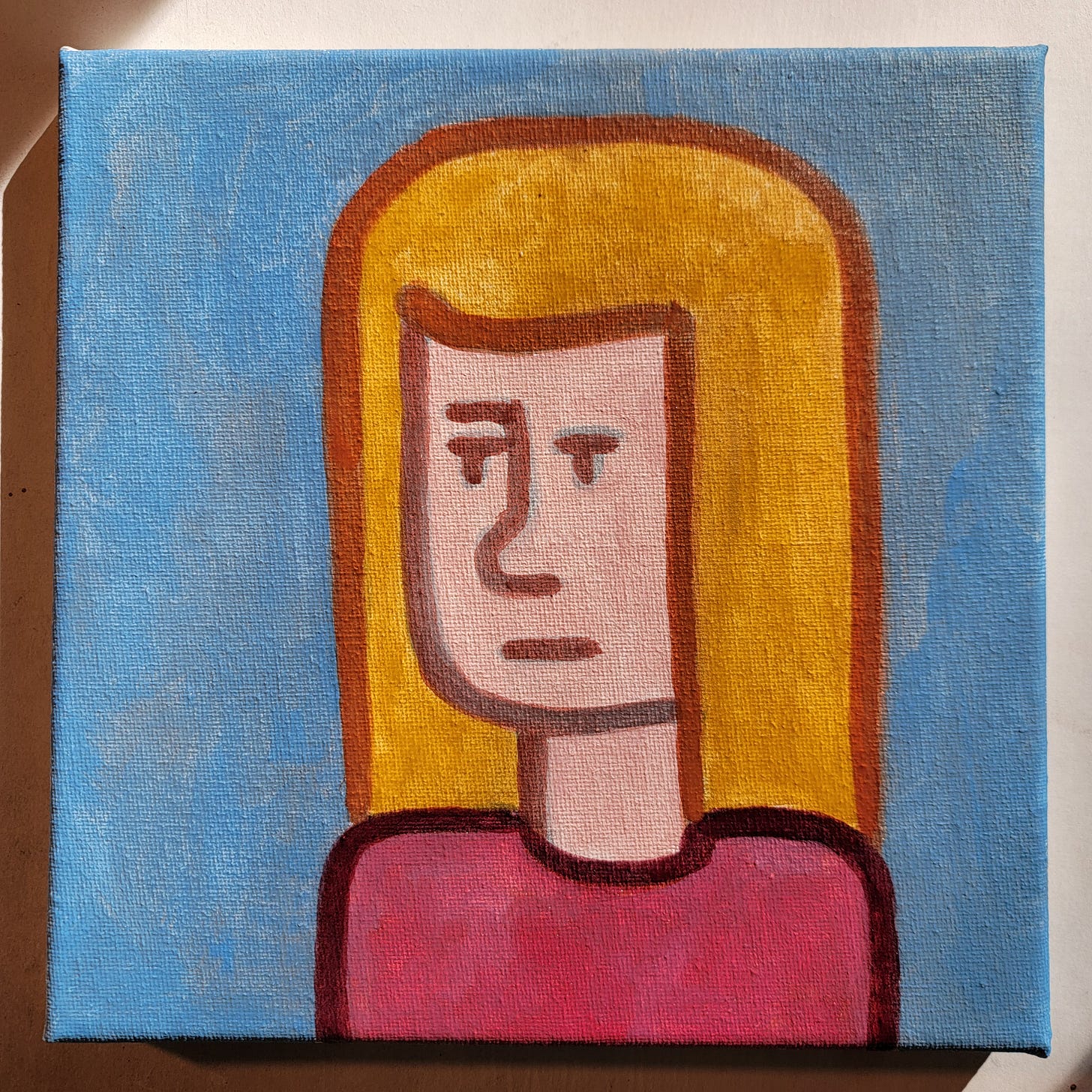
As I wrote back in September regarding the exhibition of Paula Modersohn-Becker at the Neue Galerie,
Modersohn-Becker’s painted universe was as full of children as Stettheimer’s was lacking in them. Excepting the Gauguinesque ones from around 1906, her subjects are preternaturally individual, with Sleeping Child (ca. 1904), painted in oil tempera, reminiscent of later Lucien Freud in its unsentimental observation and gritty paint handling. (To my disappointment, neither the exhibition nor the catalog explains what “oil tempera” is. It’s possible to emulsify a whole egg with linseed oil and various witch-potion additives; what little is said in the technical literature about this art-mayonnaise amounts to “Here be dragons.”)
Wehlte, in particular, gave me that impression.
The painter has a certain latitude when choosing the amount of nonaqueous component to be added to his emulsion. He can determine the character of his tempera at will, but only to the point at which it can still be diluted with water or partly diluted emulsion. If he wants to go beyond the zero-phase and change to oil tempera, it is inadvisable to add an excess of oil to water tempera. It has proved more practicable to start on the other side of the scale by adding tempera colors to oil paint, thus making the latter lean. A technically versed painter can arrive at a zero-phase emulsion even in this way, but it requires a certain experience in technical matters, as well as a sound knowledge of materials. This is not something a beginner can achieve on the first attempt. The easiest method would be to use a relatively oil-rich egg or casein tempera.1
Zero-phase, he explains elsewhere, means equally aqueous and oleaginous. More on that later.
Mayer was just as cautious.
These emulsions have been employed by experimental painters, but because no standard tradition has been established they must be closely observed and tested before being used, to make certain that they are homogenous mixtures miscible with solvent and that they will dry well.… The principal drawback to the wide acceptance of these materials has been our lack of data regarding the permanence of paints made with them.2
And then there was Doerner.
There is no end to tempera recipes. Their number is incredibly large. Most of them are not only useless but definitely harmful. All kinds of substances are mixed together in ignorance of their behavior and effects, in the quiet hope that something useful will result.3
Some recipes say to add spike oil, damar, or vinegar. Others say not to.
Modersohn-Becker’s surfaces were so gorgeous that I thought about them long after the show ended. I sent another email to the Neue to ask if anyone could give me details about her oil tempera. They didn’t reply. I returned to the books.
“Oil tempera” indicates that the medium was an emulsion. The chief question is whether the emulsion was mostly oil or mostly water. Pace Wehlte, it was probably one or the other. Mayer:
There is an impression among some that if the ingredients are properly balanced, an emulsion can be made which may be diluted with either water or turpentine. This is not a correct statement; it is not in accordance with the present theory of emulsions, and such a condition would be of doubtful value in any case.4
An emulsion is a subclass of colloids. Phases, in the context of colloids, refer to the two components of the mixture: particles, and the material in which the particles are dispersed. The chemical terms for them are the dispersed phase and the dispersion medium. (Though phase only appears in the first term, both are considered phases.) In an emulsion, both phases are liquids. Emulsions are said to be a kind of two-phase colloid. (Wehlte’s zero-phase doesn’t make much sense and doesn’t seem to be in use beyond his book.) Of the numerous ways that art materials books describe emulsions, Spurgeon’s is the least annoying: water or egg (which is mostly water) dispersed through oil is an oil phase emulsion, and the converse is water phase or egg phase.5 This clarifies at a glance whether you’d use water or oil to thin the paint.
Egg yolk is a beneficial additive for oil paint. A CNN headline last year, Scientists identify secret ingredient in Leonardo da Vinci paintings, amused those of us who have long known that egg yolk in oil lends it some of the virtues of tempera. It’s great if you need to put down precise marks. The Modersohn-Beckers look oily. But I see no point in calling an oil-heavy medium “tempera.” At this late date in the history of painting, an enormous range of mediums has been called “tempera,” including some that would more accurately be called gouache or distemper. It is the least informative designation of materials, except for another I’ve seen for Asian painting, pigments.6 But they are all water-soluble. Either Modersohn-Becker’s oil tempera is aqueous, or the Neue Galerie has done something profoundly annoying.
Massey has a half dozen recipes involving egg and oil in varying quantities, some oil phase, others water phase.7 Gottsegen8 has an aqueous emulsion recipe that is simple to make.9 Crack a whole egg into a jar and shake it. Add an equal amount of oil and shake it. Add water to an equal amount of the egg and shake it.
The traditional term for this is the Italian one, tempera grassa, literally “fat tempera.” Schadler10 has a tempera grassa recipe by name. It isn’t much more complicated than Gottsegen’s. Spurgeon’s general description of a whole-egg tempera grassa11 is the same as Gottsegen’s egg-oil emulsion paint.
The method is the same as egg tempera. Mix dry pigment with water to form a paste of the same consistency as tubed paint, then add the medium, which is roughly the viscosity of Hollandaise, in equal measure. I used bristle brushes because I felt leery of putting oil on my Kolinsky sables.
I painted a quick study on a canvas. Despite the paint consisting mostly of water, it looks surprisingly oil-like.
I am not in any way comparing this to Titian, but this surface looks strikingly like the one of The Rape of Europa, which I got to stick my face in when I wrote about its post-conservation appearance at the Gardner. At the time, conservator Gianfranco Pocobene remarked to me how exquisitely thin the paint is throughout the Europa. I have only ever heard Titian to have painted in oil. But an egg medium, which sets quickly and you can lift with a damp rag for an hour after it dries, might explain how he could develop an information-rich, opaque underpainting without contributing much to the total volume.
My study is a thin, neutral underpainting with a second layer of more intense colors, both emulsion. I don’t see why you couldn’t glaze this in oils upon drying, which it does as quickly as egg tempera when brushed out. But the open times of the paint in cups are much longer, which is convenient. I also noticed that quinacridone, which is a little hydrophobic, is much more tractable when mixed into emulsion.
It eludes me how Modersohn-Becker could paint such heavy impasto if this was her medium. She may have mulled dry pigment into the emulsion without making a paste first. One of Massey’s emulsion recipes, one part egg yolk, one part any oil or varnish, and one or more parts water, is—he claims—a thixotropic medium.12 But both Mayer and Gottsegen praise the emulsion-friendly properties of egg white, so it seems a shame to forgo it. It may be that her paintings look thicker than they are, which seems to be a benefit of emulsion. More experimentation is warranted.
Unrelated announcements: Visiting family delays the start of Merlau-Ponty in the Asynchronous Studio Book Club until next week and the calendar is producing strange errors anyway, so keep reading or take a break until I catch up. Also, I will be appearing tomorrow at 11 AM at Toadstool Books in Keene, NH to talk about Aphorisms for Artists. Hope to see you there.
Content at DMJ is free but paid subscriptions keep it coming. Please consider one for yourself and thank you for reading.
Our next title in the Asynchronous Studio Book Club is The World of Perception by Maurice Merleau-Ponty. For more information, see the ASBC homepage.
The current exhibition in the Dissident Museum is David Curcio: The Point of the Needle.
Dissident Muse’s first publication, Backseat Driver by James Croak, is available now at Amazon.
Aphorisms for Artists: 100 Ways Toward Better Art by Walter Darby Bannard is out now at Allworth Press. More information is available at the site for the book. If you own it already, thank you; please consider reviewing the book at Amazon, B&N, or Goodreads.
Kurt Wehlte, The Materials and Techniques of Painting, Kremer, 2001, p. 501.
Ralph Mayer, The Artist's Handbook of Materials and Techniques, Viking, 1991, p. 242.
Max Doerner, The Materials of the Artist and Their Use in Painting: With Notes on the Techniques of the Old Masters, HBJ, 1984, p. 212.
Mayer, p. 242.
Tad Spurgeon, Living Craft: A Painter’s Process, Zoetrope, 2017, p. 330.
For instance, this Amoghasiddhi from Tibet in the Metropolitan Museum is said to be made from “Mineral and organic pigments on cloth.” What is holding the pigments on the cloth, karma? (This work is a thousand years old and the conservators likely can’t tell. So, yes, karma.) Tibetan painting binder is often animal glue (hence distemper) and sometimes vegetable glue (hence gouache), though modern Thangka painters mostly use acrylics.
Robert Massey, Formulas for Painters, Watson-Guptill, 1967.
Mark David Gottsegen, Painter’s Handbook: Revised and Expanded, Watson-Guptill, 2006, p. 230.
That is, it was simple to make if you ignore the recipe’s demand for a sterilized jar, distilled water, and the use of the eggshell to measure proportions. Gottsegen is unwilling to let the good be the enemy of the perfect. Massey says, go ahead and paint in egg mediums on canvases. I’m on Team Massey. Make something beautiful, and posterity will figure out how to preserve it. Gottsegen warns that hard water or a stale egg sometimes produces an emulsion that doesn’t dry properly (p. 239). Here in New Hampshire we’re on a well, have a water softener, and have neighbors up the road who sell eggs from their chickens.
Koo Schadler, Egg Tempera Painting: A Comprehensive Guide, independently published, 2021.
Spurgeon, p. 334.
Massey, p. 69.






I just 💙 how this starts out as Art Crit & then morphs into a recipe column.